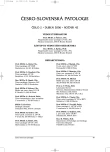Argyrophilic Grain Disease: Case Report of the First Two Cases in the Czech Republic and Review of the Literature
Nemoc s argyrofilními zrny: kazuistické sdělení prvních dvou případů diagnostikovaných v ČR a přehled literatury
Nemoc (demence) s argyrofilními zrny (AgD) patří mezi neurodegenerativní onemocnění spojená s hromaděním patologické hyperfosforylované formy tau proteinu. Klinicky se obvykle projevuje jako demence v pozdním séniu a její diagnostika je do současné doby možná pouze posmrtným neuropatologickým vyšetřením mozkové tkáně. Neuropatologické vyšetření mozkové tkáně 83letého muže a 91leté ženy s klinicky diagnostikovanou demencí bez bližší specifikace bylo doplněno impregnací solemi stříbra a imunohistochemickým průkazem tau proteinu monoklonálními protilátkami proti jeho hyperfosforylované formě. Morfologický obraz AgD je charakterizován přítomností početných argyrofilních zrn v neuropilu a specifickými perinukleárními inkluzemi v subkortikálních oligodendrogliích v oblasti spánkových laloků. V obou vyšetřovaných případech byla splněna diagnostická kritéria definitivní AgD. Jedná se o první popis tohoto dle literárních údajů relativně častého neurodegenerativního onemocnění v České republice.
Klíčová slova:
nemoc s argyrofilními zrny – demence – tau protein
Authors:
R. Matěj; F. Koukolík
Authors‘ workplace:
Department of Pathology and Working Group for Diagnosis and Study
of Neurodegenerative Disorders, Thomayer Teaching Hospital, Prague, Czech Republic
Published in:
Čes.-slov. Patol., 42, 2006, No. 2, p. 66-70
Category:
Overview
Argyrophilic grain disease (AgD) is a relatively newly described neurodegenerative disease with late-onset dementia. Morphologically it is characterized by the presence of abundant spindleshaped argyrophilic grains (ArG) in neuronal processes and coiled bodies in oligodendrocytes. ArG consist of abnormally hyperphosphorylated form of tau protein. AgD is a substrate of at least 5% of all dementia cases with increasing incidence in the old age. Here we report the cases of a 91-yearold woman and an 83-year-old man clinically diagnosed with dementia. Neuropathological, histochemical and immunohistochemical examination of the brain tissue show the changes to be compatible with a definite diagnosis of AgD. This is the first description of two cases of AgD in the Czech Republic.
Key words:
argyrophilic grain disease – dementia – tau protein
Labels
Anatomical pathology Forensic medical examiner ToxicologyArticle was published in
Czecho-Slovak Pathology

2006 Issue 2
Most read in this issue
- Argyrophilic Grain Disease: Case Report of the First Two Cases in the Czech Republic and Review of the Literature
- Tumoriform Endometriosis of the Urinary Bladder in Advanced Pregnancy
- Dedifferentiated Mixed Stromal-Smooth Muscle Tumor of the Uterus. Report of a Case
- Epithelioid Hemangioma of the Foot
